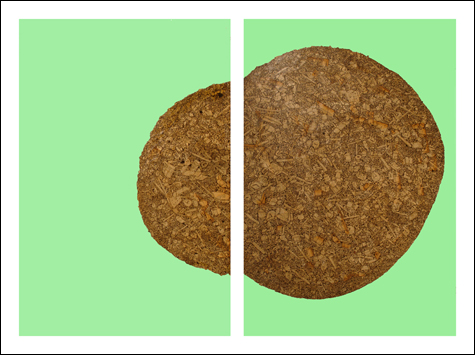
DIPTYCH ‘Mitosis,’ 2010, 24 by 48 inches, collage and oil on canvas, by Yeshe Parks.
|
It's quickly clear that something's off in Ethan Hayes-Chute's world. Though each of his drawings portrays a different sort of dwelling, no creatures stir. Instead, doors are clumsily boarded up, detritus is piled in unnatural stacks, and houses are shaped to accommodate bizarre physical dimensions. Though constructed with the fine hand and precise deliberations of architecture, this is a community of crude design, unlikely habitat, and marginal environs. It's a world formerly lived in, an alternate history, and it's hard to say whose.
As if pulled from the pages of old hardcover books, his series of tiny, two-dimensional structures and houses are rendered in vivid microscopic detail with ink and graphite on old, yellowing paper. The sepia tint of the pages and intricate realism of the drawings save these strange edifices and landscapes from the world of doodledom, where the only parameters are set by the limits of imagination. Indeed, this world has rules, and they're strangely familiar. In "Suggested Wormhouse," a tiny wooden enclosure apparently houses an ulterior pet Rover. "Forgotten Outpost" takes a surrealist approach to the topography of a contemporary American highway. "Junk Stack" depicts exactly what its title suggests.
Naturally, there are hints of morbidity and paranoia in these somewhat post-apocalyptic drawings, but the darkness is restrained by an intentional wit. "Abandoned Bagel Factory" and "Perm-a-Potty" both make cheeky, postmodern nods toward the concept of industrial hazard, and "Core Sample" puns on island life. Also, charmingly, Hayes-Chute often uses the same microscopic flourish for a blade of grass as for the tatters of a wooden door, as if the world were constantly being reassembled from the same bundle of fragmentary Legos. While these are strong, focused pieces, Hayes-Chute's 26 Assembled Thoughts battle a repetition of subject that can leave them indistinct.
The 20 works of Yeshe Parks offer a broader range of dimensions. While similarly using cutout pages of old books (both blank and printed) to simulate a foundation of antiquity, Parks layers gouache, collage, cut paper, and figure-drawing to construct a highly personal parallel world. His figures in particular are so well defined — like giant, gentle elves of indeterminate ethnicity — that their activities become vividly inhabitable. In "collect/gather" (pencil on paper), two of them are married by the task of picking up twigs, the same woven basket strapped to their backs. In "habitat/habituate" (pencil and gouache on a book cover), his characters are inoculated in an uncomfortable social exchange involving purses.
Where Parks's themes are obtuse, the images remain striking. In "das Es/das Ich," a colorful and vaguely Masonic backdrop frames streaming patterns of Germanic script and musical notation. In "Mitosis," a diptych of collage and oil on canvas, an enormous yarnball of quotidian items (TVs, couches, light bulbs, etc.) is encased in a glowing green hue. This amassed junkyard is recurrent in Parks's work, and its heavy burdens aren't found anywhere else in his curious oeuvre.